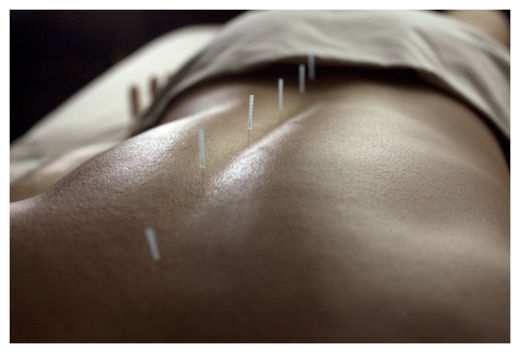
© Shelby Ross/Getty Images
Acupuncture, an ancient Chinese therapy that inserts needles into the body, reduced back and neck pain, arthritis and headaches, according to the largest analysis of the treatment.
Data compiled from 29 studies of almost 18,000 people found that acupuncture was better at relieving pain than not having the treatment at all or undergoing a sham procedure, according to research reported in the
Archives of Internal Medicine today.
About 3 million U.S. adults get acupuncture each year, mostly for chronic pain, the authors wrote. Doctors don't know why the ancient Chinese therapy can help relieve pain and more studies are needed to determine how the treatment fits with remedies such as drugs, surgery and physical and behavioral therapy, said Andrew Vickers, the lead author of the analysis.
"We thought for a long time that the reason why acupuncture worked was just because people believed it work," Vickers, a researcher at Memorial Sloan-Kettering Cancer Center in New York, said in a Sept. 7 telephone interview. "We now know that the effect of acupuncture goes above and beyond the placebo effect. Acupuncture is a reasonable option for chronic pain."
Traditional Chinese medicine explains acupuncture as a technique for balancing the flow of energy in a person's body, according to the Mayo Clinic. Inserting needles into specific points along pathways in the body changes the flow.
Pressure Points In contrast, many Western practitioners view the acupuncture points as places to stimulate nerves, muscles and connective tissue to boost blood flow and the body's natural painkillers, the Mayo Clinic said on its website.
Researchers looked at data from 17,922 patients in trials in the U.S. and Europe that measured acupuncture's effect on chronic pain. The trials compared acupuncture with patients who had no treatment or those who had a procedure that faked acupuncture by putting the needles into the body in different places and depths than usual.
The findings mean in real terms that about half of patients receiving acupuncture would have a 50 percent or more reduction in their pain compared with 30 percent in the no treatment group and about 43 percent having fake acupuncture.
The difference between treatment and sham acupuncture may be more modest because people feel better if they think they are getting the real therapy or putting any needle in the body may have some positive effect, Vickers said.
Andrew Avins, who wrote an accompanying editorial, said today's findings are important for those with chronic pain.
"For patients who are inclined to try acupuncture for a chronic pain condition, I would certainly support their interest, assuming that they have appropriate insurance coverage or the resources to readily pay for the treatment," Avins, a scientist in the Division of Research for Kaiser Permanente, an Oakland, California-based health plan, said in an e-mail. "I would also encourage patients to take advantage of all conventional interventions" to treat their pain, he said.

Reader Comments
to our Newsletter